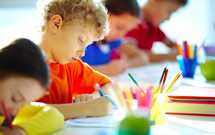Children can differ deeply in their learning ability and how easily they learn
 You may think you’re better at reading than you are at math (or vice versa), but new research suggests you’re probably equally good (or bad) at both. The reason: The genes that determine a person’s ability to tackle one subject influence their aptitude at the other, accounting for about half of a person’s overall learning ability.
You may think you’re better at reading than you are at math (or vice versa), but new research suggests you’re probably equally good (or bad) at both. The reason: The genes that determine a person’s ability to tackle one subject influence their aptitude at the other, accounting for about half of a person’s overall learning ability.
The study, published in the journal Nature Communications, used nearly 1,500 pairs of 12-year-old twins to tease apart the effects of genetic inheritance and environmental variables on math and reading ability. Twin studies provide a clever way of assessing the balance of nature versus nurture.
“Twins are like a natural experiment,” said Robert Plomin, a psychologist at Kings College London who worked on the study. Identical twins share 100 percent of their DNA and fraternal twins share 50 percent (on average), but all siblings presumably experience similar degrees of parental attentiveness, economic opportunity and so on. Different pairs of twins, in contrast, grow up in unique environments.
(Next page: Math versus reading)
The researchers administered a set of math and verbal tests to the children and then compared the performance of different sets of twins. They found that the twins’ scores–no matter if they were high or low–were twice as similar among pairs of identical twins as among pairs of fraternal twins. The results indicated that approximately half the children’s math and reading ability stemmed from their genetic makeup.
A complementary analysis of unrelated kids corroborated this conclusion–strangers with equivalent academic abilities shared genetic similarities.
What’s more, the genes responsible for math and reading ability appear to be numerous and interconnected, not specifically targeted toward one set of skills. These so-called “generalist genes” act in concert to determine a child’s aptitude across multiple disciplines.
“If you found genes for reading,” Plomin said, “you have over a 50 percent chance that those same genes would influence math.”
That’s not to say specialized brain circuits don’t exist for different tasks, said Timothy Bates, a psychologist at the University of Edinburgh who was not involved in the study.
“If those ‘squiggles on a page’ the young child encounters are math or prose, different brain systems, with different genes, are involved in learning to decode them,” he said. The new study just illustrates that these genes build on a more general foundation of learning ability, he said.
The finding that one’s propensities for math and reading go hand in hand may come as a surprise to many, but it shouldn’t. People often feel that they possess skills in only one area simply because they perform slightly worse in the other, Plomin said. But it’s all relative.
“You might think you’re a little less good at math, but compared to everybody in the world, you’re pretty good at math,” he said.
That’s great news for those who came out on top of the genetic lottery, but what about everyone else?
“We don’t want to pit nature vs. nurture,” Plomin said. “But for parents who still think kids are a blob of clay that you mold to be what you want them to be, I hope this data–and there’s tons of other data like this–will convince people to recognize and respect individual differences that are genetically driven.”
He sees parallels to obesity: People can no more control a genetic predisposition that causes them to struggle with arithmetic than they can control an inherited tendency to put on pounds. That doesn’t mean nothing can be done to bring those students up to par–it just might take more effort.
Plomin suggests individually tailored educational approaches could help, in which students could learn at different rates using different techniques, potentially assisted by the growing role of technology in the classroom. Finland consistently dominates international education rankings, and Plomin points to its strategy as a good example.
Finland has decided to do “whatever it takes” to bring every child up to a minimum level of literacy and numeracy needed to survive in the modern world. In practice, this has meant reducing class sizes, trying alternative learning approaches, and spending hours outside of class with any student who needs it.
Plomin also points out that genes don’t predetermine performance. Appetite is just as important as aptitude, he said.
“The brilliant mathematician–that’s all they do for decades, they just think math and work on math,” Plomin said. “It’s not like it comes to them with a flash of inspiration. It’s really a long, long process of thinking about these things.”
The study results show that attitudes about learning are out of date and need to change, Bates said.
“Just as we no longer blame mothers for schizophrenia, we should be humble when blaming schools and parents for not every child learning as quickly as we’d desire,” he said. “The implications, I think, are that children really do differ at very deep levels in how easily they learn.”
(c)2014 Los Angeles Times. Visit the Los Angeles Times at www.latimes.com. Distributed by MCT Information Services.
- ‘Buyer’s remorse’ dogging Common Core rollout - October 30, 2014
- Calif. law targets social media monitoring of students - October 2, 2014
- Elementary world language instruction - September 25, 2014

